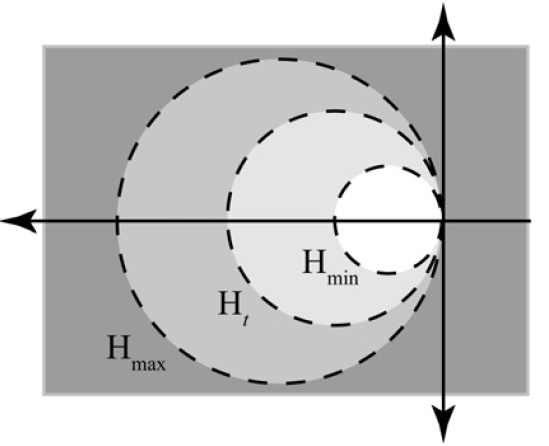Difference between revisions of "Unilateral Laplace transform"
(→Properties of Laplace Transforms) |
|||
| Line 1: | Line 1: | ||
Let $\mathbb{T}$ be a [[time_scale | time scale]] and let $s \in \mathbb{T}$. If $f \in C_{rd}(\mathbb{T},\mathbb{C})$ ([[continuity | rd-continuous]]) then we define the Laplace transform of $f$ about $s$ by the formula <ref>Bohner, Martin ; Guseinov, Gusein Sh. ; Karpuz, Başak . Properties of the Laplace transform on time scales with arbitrary graininess. Integral Transforms Spec. Funct. 22 (2011), no. 11, pp.793.</ref> | Let $\mathbb{T}$ be a [[time_scale | time scale]] and let $s \in \mathbb{T}$. If $f \in C_{rd}(\mathbb{T},\mathbb{C})$ ([[continuity | rd-continuous]]) then we define the Laplace transform of $f$ about $s$ by the formula <ref>Bohner, Martin ; Guseinov, Gusein Sh. ; Karpuz, Başak . Properties of the Laplace transform on time scales with arbitrary graininess. Integral Transforms Spec. Funct. 22 (2011), no. 11, pp.793.</ref> | ||
| − | $$\mathscr{L}\{f\}(z;s) = \displaystyle\int_s^{\infty} f(t) e_{\ominus z}(\sigma(t), | + | $$\mathscr{L}\{f\}(z;s) = \displaystyle\int_s^{\infty} f(t) e_{\ominus z}(\sigma(t),s) \Delta t,$$ |
where $z$ lives in a domain $D \subset \mathbb{C}$ for which the integral converges. Let $\alpha$ be a non-negative [[regressive_function | regressive]] constant larger than $s$. We use the notation "$f(t;s)$" to denote we are thinking of $f$ as a function of $t$ with parameter $s$. | where $z$ lives in a domain $D \subset \mathbb{C}$ for which the integral converges. Let $\alpha$ be a non-negative [[regressive_function | regressive]] constant larger than $s$. We use the notation "$f(t;s)$" to denote we are thinking of $f$ as a function of $t$ with parameter $s$. | ||
Revision as of 18:35, 23 June 2014
Let $\mathbb{T}$ be a time scale and let $s \in \mathbb{T}$. If $f \in C_{rd}(\mathbb{T},\mathbb{C})$ ( rd-continuous) then we define the Laplace transform of $f$ about $s$ by the formula <ref>Bohner, Martin ; Guseinov, Gusein Sh. ; Karpuz, Başak . Properties of the Laplace transform on time scales with arbitrary graininess. Integral Transforms Spec. Funct. 22 (2011), no. 11, pp.793.</ref> $$\mathscr{L}\{f\}(z;s) = \displaystyle\int_s^{\infty} f(t) e_{\ominus z}(\sigma(t),s) \Delta t,$$ where $z$ lives in a domain $D \subset \mathbb{C}$ for which the integral converges. Let $\alpha$ be a non-negative regressive constant larger than $s$. We use the notation "$f(t;s)$" to denote we are thinking of $f$ as a function of $t$ with parameter $s$.
| Function $f(t;s)$ | Laplace Transformation $\mathscr{L}\{f(\cdot;s)\}(z)$ |
| $e_{\alpha}(t;s)$ | $\dfrac{1}{z-\alpha}$ |
| $h_n(t;s)$ | $\dfrac{1}{z^{n+1}}$ |
| $\sinh_{\alpha}(t;s)$ | $\dfrac{\alpha}{z^2-\alpha^2}$ |
| $\cosh_{\alpha}(t;s)$ | $\dfrac{z}{z^2-\alpha^2}$ |
| $\sin_{\alpha}(t;s)$ | $\dfrac{\alpha}{z^2+\alpha^2}$ |
| $\cos_{\alpha}(t;s)$ | $\dfrac{z}{z^2+\alpha^2}$ |
Properties of Laplace Transforms
- The Laplace transform is linear, i.e. for constants $\alpha, \beta$ and Laplace-transformable functions $f,g$, <ref>Bohner, Martin ; Guseinov, Gusein Sh. ; Karpuz, Başak . Properties of the Laplace transform on time scales with arbitrary graininess. Integral Transforms Spec. Funct. 22 (2011), no. 11, pp.795.</ref>
$$\mathscr{L}\{\alpha f + \beta g\} = \alpha \mathscr{L}\{f\} + \beta \mathscr{L}\{g\}.$$
- Assume there exist $M,\alpha > 0$ with
$$|a_k| \leq M \alpha_k$$ for all $k=0,1,2,\ldots$. Then for all $z$ where it exists, <ref>Bohner, Martin ; Guseinov, Gusein Sh. ; Karpuz, Başak . Properties of the Laplace transform on time scales with arbitrary graininess. Integral Transforms Spec. Funct. 22 (2011), no. 11, pp.796.</ref> $$\mathscr{L}\left\{ \displaystyle\sum_{k=0}^{\infty} a_k h_k(\cdot,s) \right\}(z;s) = \displaystyle\sum_{k=0}^{\infty} a_k \mathscr{L}\{h_k(\cdot,s)\}(z;s) = \displaystyle\sum_{k=0}^{\infty} \dfrac{a_k}{z^{k+1}},$$ where $h_k$ denotes the standard time scale polynomial.
- Let $m_z(t,s):=\displaystyle\int_s^t \dfrac{\Delta \tau}{1+\mu(\tau)z}$. Then <ref>Bohner, Martin ; Guseinov, Gusein Sh. ; Karpuz, Başak . Properties of the Laplace transform on time scales with arbitrary graininess. Integral Transforms Spec. Funct. 22 (2011), no. 11, pp.797.</ref>
$$\dfrac{d}{dz} \mathscr{L}\{f\}(z;s) = -\mathscr{L}\{m_z(\sigma(\cdot),s)f\}(z;s).$$ This happens because $\dfrac{d}{dz} e_z(t,t_0) = m_z(t,t_0)e_z(t,t_0)$ and $\dfrac{d}{dz} e_{\ominus z}(t,t_0)=-m_z(t,t_0)e_{\ominus z}(t,t_0)$. These formulas are analogues of the formulas $\dfrac{d}{dz} e^{z(t-t_0)}=(t-t_0)e^{z(t-t_0)}$ and $\dfrac{d}{dz} e^{-z(t-t_0)}=-(t-t_0)e^{-z(t-t_0)}$ which occur in the case $\mathbb{T}=\mathbb{R}$.
Inverse Transform on isolated time scales
The following information is from <ref>Davis, John M. ; Gravagne, Ian A. ; Jackson, Billy J. ; Marks, Robert J., II ; Ramos, Alice A. The Laplace transform on time scales revisited.
J. Math. Anal. Appl. 332 (2007), no. 2, 1291--1307.</ref>. Define the notation
$$\mathrm{Re}_h(z) := \dfrac{1}{h} (|1+hz|-1).$$ Let $\mathbb{T}$ be a time scale with $0 < \mu_{\mathrm{min}} \leq \mu(t) \leq \mu_{\mathrm{max}} < \infty.$ Let $\mu_* := \mu_{\mathrm{min}}$ and $\mu^* := \mu_{\mathrm{max}}$. Define in $\mathbb{C}$ the Hilger circles $$\mathbb{H}_{\mu(t)} = \left\{ z \in \mathbb{C} \colon 0 < \left| z + \dfrac{1}{\mu(t)} \right| < \dfrac{1}{\mu(t)} \right\},$$ which are disks centered at $\left(-\dfrac{1}{\mu(t)},0 \right)$ with radius $\dfrac{1}{\mu(t)}$.
These circles define the region of convergence for the Laplace transform $\mathscr{L}_\mathbb{T}$. If $\mu_*=0$, then the region of convergence is the right half plane, but if $\mu_*>0$ the region of convergence is outside of $\mathbb{H}_{\mu_*}$.
Theorem: Suppose that $F(z)$ is analytic in the region $\mathrm{Re}_{\mu}(z)>\mathrm{Re}_{\mu}(c)$ and $F(z) \rightarrow 0$ uniformly as $|z| \rightarrow \infty$ in this region. Suppose $F(z)$ has finitely many regressive poles of finite order $\{z_1,\ldots,z_n\}$ and $\tilde{F}_{\mathbb{R}}(z)$ is the transform of the function $\tilde{f}(t)$ on $\mathbb{R}$ that corresponds to the transform $F(z)=F_{\mathbb{T}}(z)$ of $f(t)$ on $\mathbb{T}$. If $$\displaystyle\int_{c-i\infty}^{c+i\infty} |\tilde{F}_{\mathbb{R}}(z)||dz|<\infty,$$ then $$f(t)=\displaystyle\sum_{i=1}^n \mathrm{Res}_{z=z_i} e_z(t,0) F(z)$$ has transform $F(z)$ for all $z$ with $\mathrm{Re}(z)>c$. $\blacksquare$
References
<references />
